Product Info Summary
| SKU: | M01009-2 |
|---|---|
| Size: | 100 μg/vial |
| Reactive Species: | Human, Mouse, Rat |
| Host: | Mouse |
| Application: | Flow Cytometry, IF, IHC, ICC, WB |
Customers Who Bought This Also Bought
Product info
Product Name
Anti-splicing factor 1 Antibody Picoband® (monoclonal, 2F5D10)
View all Splicing Factor 1 Antibodies
SKU/Catalog Number
M01009-2
Size
100 μg/vial
Form
Lyophilized
Description
Boster Bio Anti-splicing factor 1 Antibody Picoband® (monoclonal, 2F5D10) catalog # M01009-2. Tested in Flow Cytometry, IF, IHC, ICC, WB applications. This antibody reacts with Human, Mouse, Rat. The brand Picoband indicates this is a premium antibody that guarantees superior quality, high affinity, and strong signals with minimal background in Western blot applications. Only our best-performing antibodies are designated as Picoband, ensuring unmatched performance.
Storage & Handling
At -20°C for one year from date of receipt. After reconstitution, at 4°C for one month. It can also be aliquotted and stored frozen at -20°C for six months. Avoid repeated freezing and thawing.
Cite This Product
Anti-splicing factor 1 Antibody Picoband® (monoclonal, 2F5D10) (Boster Biological Technology, Pleasanton CA, USA, Catalog # M01009-2)
Host
Mouse
Contents
Each vial contains 4 mg Trehalose, 0.9 mg NaCl and 0.2 mg Na2HPO4.
Clonality
Monoclonal
Clone Number
2F5D10
Isotype
Mouse IgG2a
Immunogen
E. coli-derived human splicing factor 1 recombinant protein (Position: R160-Q266).
*Blocking peptide can be purchased. Costs vary based on immunogen length. Contact us for pricing.
Cross-reactivity
No cross-reactivity with other proteins.
Reactive Species
M01009-2 is reactive to SF1 in Human, Mouse, Rat
Reconstitution
Adding 0.2 ml of distilled water will yield a concentration of 500 μg/ml.
Observed Molecular Weight
68 kDa
Calculated molecular weight
68.33kDa
Background of Splicing Factor 1
Splicing factor 1 also known as zinc finger protein 162 (ZFM162) is a protein that in humans is encoded by the SF1 gene. This gene encodes a nuclear pre-mRNA splicing factor. The encoded protein specifically recognizes the intron branch point sequence at the 3' splice site, together with the large subunit of U2 auxiliary factor (U2AF), and is required for the early stages of spliceosome assembly. It also plays a role in nuclear pre-mRNA retention and transcriptional repression. The encoded protein contains an N-terminal U2AF ligand motif, a central hnRNP K homology motif and quaking 2 region which bind a key branch-site adenosine within the branch point sequence, a zinc knuckles domain, and a C-terminal proline-rich domain. Alternative splicing results in multiple transcript variants.
Antibody Validation
Boster validates all antibodies on WB, IHC, ICC, Immunofluorescence, and ELISA with known positive control and negative samples to ensure specificity and high affinity, including thorough antibody incubations.
Application & Images
Applications
M01009-2 is guaranteed for Flow Cytometry, IF, IHC, ICC, WB Boster Guarantee
Assay Dilutions Recommendation
The recommendations below provide a starting point for assay optimization. The actual working concentration varies and should be decided by the user.
Western blot, 0.25-0.5 μg/ml, Human, Mouse, Rat
Immunohistochemistry(Paraffin-embedded Section), 2-5 μg/ml, Human, Mouse, Rat
Immunocytochemistry/Immunofluorescence, 5 μg/ml, Human
Flow Cytometry (Fixed), 1-3 μg/1x106 cells, Human, Mouse, Rat
Positive Control
WB: human SKOV-3 whole cell, human K562 whole cell, human THP-1 whole cell, human A549 whole cell, rat PC-12 whole cell, mouse NIH/3T3 whole cell
IHC: human bladder cancer tissue, human breast cancer tissue, human liver cancer tissue, human placenta tissue, human squamous metaplasia of the renal pelvis tissue, mouse colon tissue, mouse kidney tissue, rat colon tissue, rat kidney tissue
ICC/IF: A431 cell
FCM: A431 cell, Neuro-2a cell, C6 cell
Validation Images & Assay Conditions
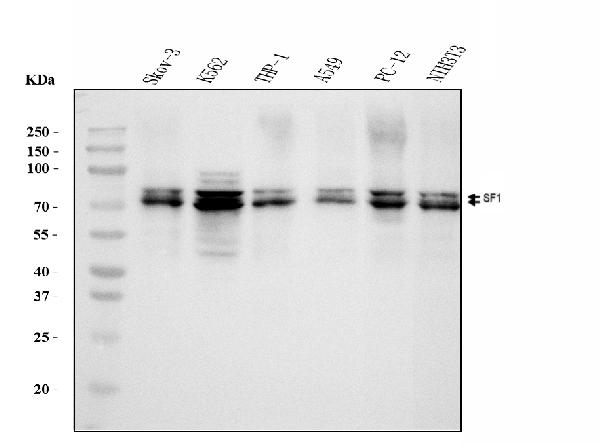
Click image to see more details
Figure 1. Western blot analysis of splicing factor 1 using anti-splicing factor 1 antibody (M01009-2).
Electrophoresis was performed on a 5-20% SDS-PAGE gel at 70V (Stacking gel) / 90V (Resolving gel) for 2-3 hours. The sample well of each lane was loaded with 30 ug of sample under reducing conditions.
Lane 1: human SKOV-3 whole cell lysates,
Lane 2: human K562 whole cell lysates,
Lane 3: human THP-1 whole cell lysates,
Lane 4: human A549 whole cell lysates,
Lane 5: rat PC-12 whole cell lysates,
Lane 6: mouse NIH/3T3 whole cell lysates.
After electrophoresis, proteins were transferred to a nitrocellulose membrane at 150 mA for 50-90 minutes. Blocked the membrane with 5% non-fat milk/TBS for 1.5 hour at RT. The membrane was incubated with mouse anti-splicing factor 1 antigen affinity purified monoclonal antibody (Catalog # M01009-2) at 0.5 μg/mL overnight at 4°C, then washed with TBS-0.1%Tween 3 times with 5 minutes each and probed with a goat anti-mouse IgG-HRP secondary antibody at a dilution of 1:10000 for 1.5 hour at RT. The signal is developed using an Enhanced Chemiluminescent detection (ECL) kit (Catalog # EK1001) with Tanon 5200 system. A specific band was detected for splicing factor 1 at approximately 68 kDa. The expected band size for splicing factor 1 is at 68 kDa.
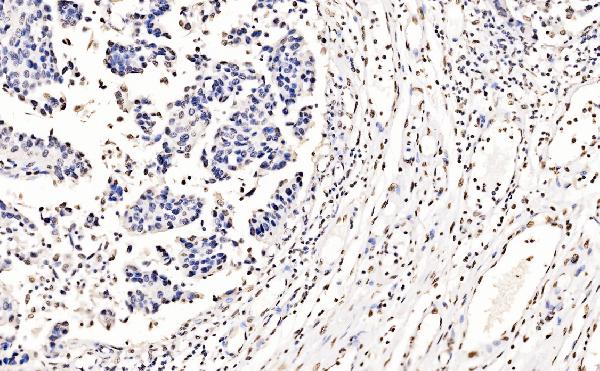
Click image to see more details
Figure 2. IHC analysis of splicing factor 1 using anti-splicing factor 1 antibody (M01009-2).
splicing factor 1 was detected in a paraffin-embedded section of human bladder cancer tissue. Heat mediated antigen retrieval was performed in EDTA buffer (pH 8.0, epitope retrieval solution). The tissue section was blocked with 10% goat serum. The tissue section was then incubated with 2 μg/ml mouse anti-splicing factor 1 Antibody (M01009-2) overnight at 4°C. Biotinylated goat anti-mouse IgG was used as secondary antibody and incubated for 30 minutes at 37°C. The tissue section was developed using Strepavidin-Biotin-Complex (SABC) (Catalog # SA1021) with DAB as the chromogen.
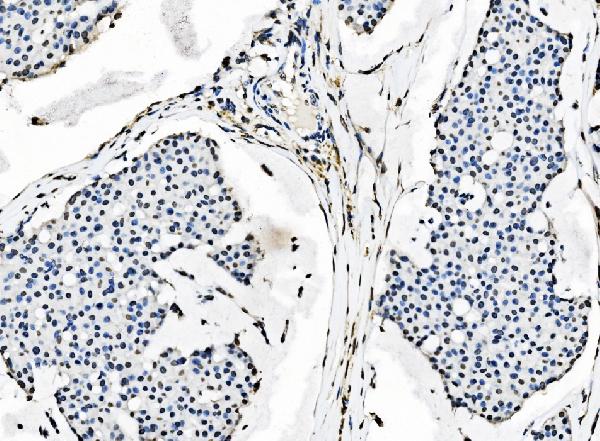
Click image to see more details
Figure 3. IHC analysis of splicing factor 1 using anti-splicing factor 1 antibody (M01009-2).
splicing factor 1 was detected in a paraffin-embedded section of human breast cancer tissue. Heat mediated antigen retrieval was performed in EDTA buffer (pH 8.0, epitope retrieval solution). The tissue section was blocked with 10% goat serum. The tissue section was then incubated with 2 μg/ml mouse anti-splicing factor 1 Antibody (M01009-2) overnight at 4°C. Biotinylated goat anti-mouse IgG was used as secondary antibody and incubated for 30 minutes at 37°C. The tissue section was developed using Strepavidin-Biotin-Complex (SABC) (Catalog # SA1021) with DAB as the chromogen.
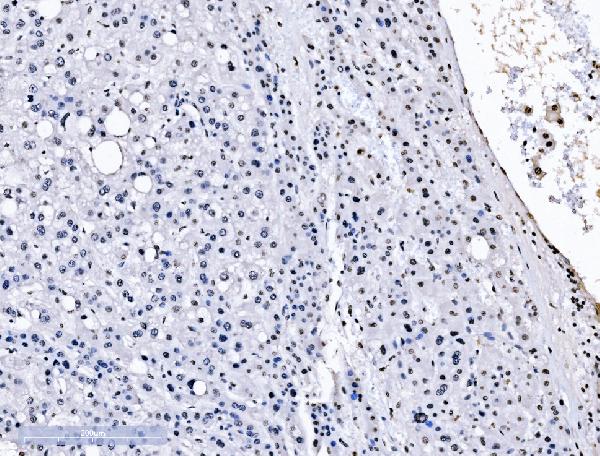
Click image to see more details
Figure 4. IHC analysis of splicing factor 1 using anti-splicing factor 1 antibody (M01009-2).
splicing factor 1 was detected in a paraffin-embedded section of human liver cancer tissue. Heat mediated antigen retrieval was performed in EDTA buffer (pH 8.0, epitope retrieval solution). The tissue section was blocked with 10% goat serum. The tissue section was then incubated with 2 μg/ml mouse anti-splicing factor 1 Antibody (M01009-2) overnight at 4°C. Biotinylated goat anti-mouse IgG was used as secondary antibody and incubated for 30 minutes at 37°C. The tissue section was developed using Strepavidin-Biotin-Complex (SABC) (Catalog # SA1021) with DAB as the chromogen.
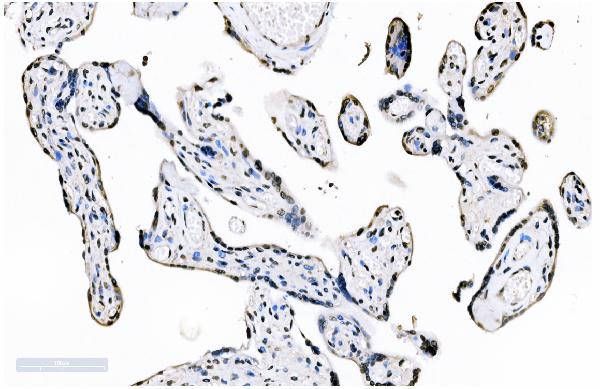
Click image to see more details
Figure 5. IHC analysis of splicing factor 1 using anti-splicing factor 1 antibody (M01009-2).
splicing factor 1 was detected in a paraffin-embedded section of human placenta tissue. Heat mediated antigen retrieval was performed in EDTA buffer (pH 8.0, epitope retrieval solution). The tissue section was blocked with 10% goat serum. The tissue section was then incubated with 2 μg/ml mouse anti-splicing factor 1 Antibody (M01009-2) overnight at 4°C. Biotinylated goat anti-mouse IgG was used as secondary antibody and incubated for 30 minutes at 37°C. The tissue section was developed using Strepavidin-Biotin-Complex (SABC) (Catalog # SA1021) with DAB as the chromogen.
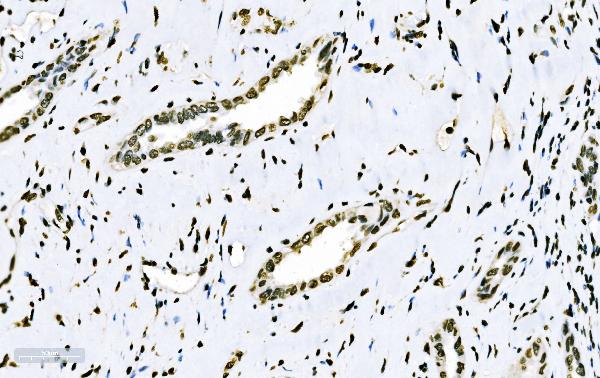
Click image to see more details
Figure 6. IHC analysis of splicing factor 1 using anti-splicing factor 1 antibody (M01009-2).
splicing factor 1 was detected in a paraffin-embedded section of human squamous metaplasia of the renal pelvis tissue. Heat mediated antigen retrieval was performed in EDTA buffer (pH 8.0, epitope retrieval solution). The tissue section was blocked with 10% goat serum. The tissue section was then incubated with 2 μg/ml mouse anti-splicing factor 1 Antibody (M01009-2) overnight at 4°C. Biotinylated goat anti-mouse IgG was used as secondary antibody and incubated for 30 minutes at 37°C. The tissue section was developed using Strepavidin-Biotin-Complex (SABC) (Catalog # SA1021) with DAB as the chromogen.
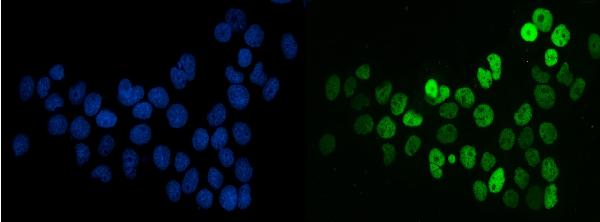
Click image to see more details
Figure 7. IF analysis of splicing factor 1 using anti-splicing factor 1 antibody (M01009-2).
splicing factor 1 was detected in an immunocytochemical section of A431 cells. Enzyme antigen retrieval was performed using IHC enzyme antigen retrieval reagent (AR0022) for 15 mins. The cells were blocked with 10% goat serum. And then incubated with 5 μg/mL mouse anti-splicing factor 1 Antibody (M01009-2) overnight at 4°C. DyLight®488 Conjugated Goat Anti-Mouse IgG (BA1126) was used as secondary antibody at 1:100 dilution and incubated for 30 minutes at 37°C. The section was counterstained with DAPI. Visualize using a fluorescence microscope and filter sets appropriate for the label used.
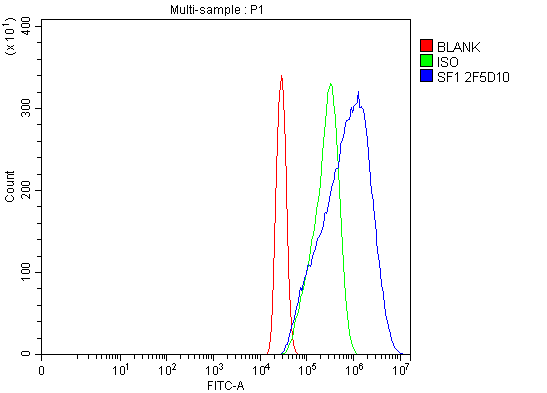
Click image to see more details
Figure 8. Flow Cytometry analysis of A431 cells using anti-splicing factor 1 antibody (M01009-2).
Overlay histogram showing A431 cells stained with M01009-2 (Blue line). To facilitate intracellular staining, cells were fixed with 4% paraformaldehyde and permeabilized with permeabilization buffer. The cells were blocked with 10% normal goat serum. And then incubated with mouse anti-splicing factor 1 Antibody (M01009-2, 1 μg/1x106 cells) for 30 min at 20°C. DyLight®488 conjugated goat anti-mouse IgG (BA1126, 5-10 μg/1x106 cells) was used as secondary antibody for 30 minutes at 20°C. Isotype control antibody (Green line) was mouse IgG (1 μg/1x106) used under the same conditions. Unlabelled sample without incubation with primary antibody and secondary antibody (Red line) was used as a blank control.
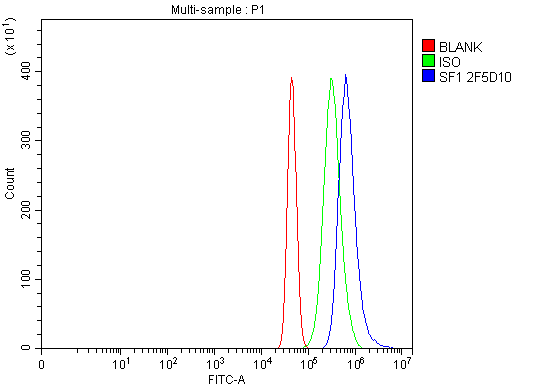
Click image to see more details
Figure 9. Flow Cytometry analysis of Neuro-2a cells using anti-splicing factor 1 antibody (M01009-2).
Overlay histogram showing Neuro-2a cells stained with M01009-2 (Blue line). To facilitate intracellular staining, cells were fixed with 4% paraformaldehyde and permeabilized with permeabilization buffer. The cells were blocked with 10% normal goat serum. And then incubated with mouse anti-splicing factor 1 Antibody (M01009-2, 1 μg/1x106 cells) for 30 min at 20°C. DyLight®488 conjugated goat anti-mouse IgG (BA1126, 5-10 μg/1x106 cells) was used as secondary antibody for 30 minutes at 20°C. Isotype control antibody (Green line) was mouse IgG (1 μg/1x106) used under the same conditions. Unlabelled sample without incubation with primary antibody and secondary antibody (Red line) was used as a blank control.
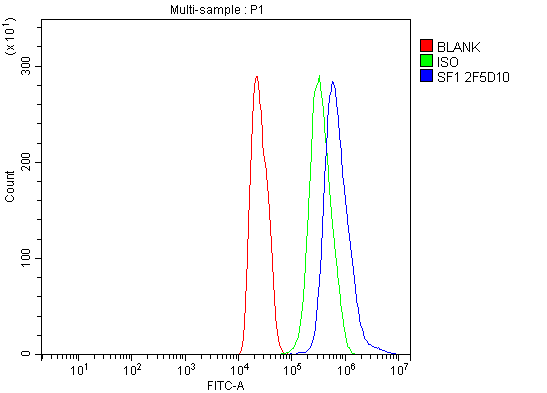
Click image to see more details
Figure 10. Flow Cytometry analysis of C6 cells using anti-splicing factor 1 antibody (M01009-2).
Overlay histogram showing C6 cells stained with M01009-2 (Blue line). To facilitate intracellular staining, cells were fixed with 4% paraformaldehyde and permeabilized with permeabilization buffer. The cells were blocked with 10% normal goat serum. And then incubated with mouse anti-splicing factor 1 Antibody (M01009-2, 1 μg/1x106 cells) for 30 min at 20°C. DyLight®488 conjugated goat anti-mouse IgG (BA1126, 5-10 μg/1x106 cells) was used as secondary antibody for 30 minutes at 20°C. Isotype control antibody (Green line) was mouse IgG (1 μg/1x106) used under the same conditions. Unlabelled sample without incubation with primary antibody and secondary antibody (Red line) was used as a blank control.

Click image to see more details
Figure 11. IHC analysis of splicing factor 1 using anti-splicing factor 1 antibody (M01009-2).
splicing factor 1 was detected in a paraffin-embedded section of mouse colon tissue. Heat mediated antigen retrieval was performed in EDTA buffer (pH 8.0, epitope retrieval solution). The tissue section was blocked with 10% goat serum. The tissue section was then incubated with 2 μg/ml mouse anti-splicing factor 1 Antibody (M01009-2) overnight at 4°C. Biotinylated goat anti-mouse IgG was used as secondary antibody and incubated for 30 minutes at 37°C. The tissue section was developed using Strepavidin-Biotin-Complex (SABC) (Catalog # SA1021) with DAB as the chromogen.

Click image to see more details
Figure 12. IHC analysis of splicing factor 1 using anti-splicing factor 1 antibody (M01009-2).
splicing factor 1 was detected in a paraffin-embedded section of mouse kidney tissue. Heat mediated antigen retrieval was performed in EDTA buffer (pH 8.0, epitope retrieval solution). The tissue section was blocked with 10% goat serum. The tissue section was then incubated with 2 μg/ml mouse anti-splicing factor 1 Antibody (M01009-2) overnight at 4°C. Biotinylated goat anti-mouse IgG was used as secondary antibody and incubated for 30 minutes at 37°C. The tissue section was developed using Strepavidin-Biotin-Complex (SABC) (Catalog # SA1021) with DAB as the chromogen.

Click image to see more details
Figure 13. IHC analysis of splicing factor 1 using anti-splicing factor 1 antibody (M01009-2).
splicing factor 1 was detected in a paraffin-embedded section of rat colon tissue. Heat mediated antigen retrieval was performed in EDTA buffer (pH 8.0, epitope retrieval solution). The tissue section was blocked with 10% goat serum. The tissue section was then incubated with 2 μg/ml mouse anti-splicing factor 1 Antibody (M01009-2) overnight at 4°C. Biotinylated goat anti-mouse IgG was used as secondary antibody and incubated for 30 minutes at 37°C. The tissue section was developed using Strepavidin-Biotin-Complex (SABC) (Catalog # SA1021) with DAB as the chromogen.

Click image to see more details
Figure 14. IHC analysis of splicing factor 1 using anti-splicing factor 1 antibody (M01009-2).
splicing factor 1 was detected in a paraffin-embedded section of rat kidney tissue. Heat mediated antigen retrieval was performed in EDTA buffer (pH 8.0, epitope retrieval solution). The tissue section was blocked with 10% goat serum. The tissue section was then incubated with 2 μg/ml mouse anti-splicing factor 1 Antibody (M01009-2) overnight at 4°C. Biotinylated goat anti-mouse IgG was used as secondary antibody and incubated for 30 minutes at 37°C. The tissue section was developed using Strepavidin-Biotin-Complex (SABC) (Catalog # SA1021) with DAB as the chromogen.
Protein Target Info & Infographic
Gene/Protein Information For SF1 (Source: Uniprot.org, NCBI)
Gene Name
SF1
Full Name
Splicing factor 1
Weight
68.33kDa
Superfamily
BBP/SF1 family
Alternative Names
ATP-dependent Clp protease ATP-binding subunit clpX-like, mitochondrial; CLPX SF1 BBP, D11S636, MBBP, ZCCHC25, ZFM1, ZNF162 splicing factor 1 splicing factor 1|mammalian branch point-binding protein|transcription factor ZFM1|zinc finger gene in MEN1 locus|zinc finger protein 162
*If product is indicated to react with multiple species, protein info is based on the gene entry specified above in "Species".For more info on SF1, check out the SF1 Infographic

We have 30,000+ of these available, one for each gene! Check them out.
In this infographic, you will see the following information for SF1: database IDs, superfamily, protein function, synonyms, molecular weight, chromosomal locations, tissues of expression, subcellular locations, post-translational modifications, and related diseases, research areas & pathways. If you want to see more information included, or would like to contribute to it and be acknowledged, please contact [email protected].
Specific Publications For Anti-splicing factor 1 Antibody Picoband® (monoclonal, 2F5D10) (M01009-2)
Hello CJ!
No publications found for M01009-2
*Do you have publications using this product? Share with us and receive a reward. Ask us for more details.
Recommended Resources
Here are featured tools and databases that you might find useful.
- Boster's Pathways Library
- Protein Databases
- Bioscience Research Protocol Resources
- Data Processing & Analysis Software
- Photo Editing Software
- Scientific Literature Resources
- Research Paper Management Tools
- Molecular Biology Software
- Primer Design Tools
- Bioinformatics Tools
- Phylogenetic Tree Analysis
Customer Reviews
Have you used Anti-splicing factor 1 Antibody Picoband® (monoclonal, 2F5D10)?
Submit a review and receive an Amazon gift card.
- $30 for a review with an image
0 Reviews For Anti-splicing factor 1 Antibody Picoband® (monoclonal, 2F5D10)
Customer Q&As
Have a question?
Find answers in Q&As, reviews.
Can't find your answer?
Submit your question





